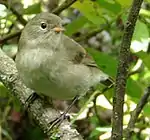Warbler-finch
The warbler-finches are a genus Certhidea of birds in the tanager family Thraupidae that are endemic to the Galápagos Islands. Together with related genera, they are collectively known as Darwin's finches.
| Warbler-finches | |
|---|---|
 | |
| Grey warbler-finch (Certhidea fusca) | |
| Scientific classification | |
| Domain: | Eukaryota |
| Kingdom: | Animalia |
| Phylum: | Chordata |
| Class: | Aves |
| Order: | Passeriformes |
| Family: | Thraupidae |
| Genus: | Certhidea Gould, 1837 |
| Type species | |
| Certhidea olivacea Gould, 1837 | |
| Species | |
|
C. olivacea | |
The two species were formerly considered to be conspecific; however, they have different songs, prefer different habitats, and are located in different areas on the islands.[1]
Taxonomy and species list
The genus Certhidea was introduced in 1837 by the English ornithologist John Gould with the green warbler-finch as the type species.[2][3] The name is a Latin diminutive of the genus Certhia introduced by Carl Linnaeus in 1758 for the treecreepers.[4] The members of the genus form part of a group collectively known as Darwin's finches.[5] Although traditionally placed with the buntings and New World sparrows in the family Emberizidae,[3] molecular phylogenetic studies have shown that Darwin's finches are members of the subfamily Coerebinae within the tanager family Thraupidae.[6] The genus contains two species.[7]
| Image | Scientific name | Common Name | Distribution |
|---|---|---|---|
 | Certhidea olivacea | Green warbler-finch | Galápagos Islands, Ecuador |
 | Certhidea fusca | Grey warbler-finch | Galápagos Islands, Ecuador. |
References
- South American Classification Committee (September 1, 2011). "Proposal (#367) to South American Classification Committee – Split the Warbler Finches: Certhidea fusca from Certhidea olivacea". Retrieved November 10, 2009.
- Gould, John (1837). "Remarks on a group of Ground Finches from Mr. Darwin's collection, with characters of new species". Proceedings of the Zoological Society of London. Part 5 (49): 4–7 [7].
- Paynter, Raymond A. Jr, ed. (1970). Check-List of Birds of the World. Vol. 13. Cambridge, Massachusetts: Museum of Comparative Zoology. p. 166.
- Jobling, James A. (2010). The Helm Dictionary of Scientific Bird Names. London: Christopher Helm. p. 97. ISBN 978-1-4081-2501-4.
- Sato, A.; Tichy, H.; O'hUigin, C.; Grant, P.R.; Grant, B.R.; Klein, J. (2001). "On the origin of Darwin's Finches". Molecular Biology and Evolution. 18 (3): 299–311. doi:10.1093/oxfordjournals.molbev.a003806. PMID 11230531.
- Burns, K.J.; Shultz, A.J.; Title, P.O.; Mason, N.A.; Barker, F.K.; Klicka, J.; Lanyon, S.M.; Lovette, I.J. (2014). "Phylogenetics and diversification of tanagers (Passeriformes: Thraupidae), the largest radiation of Neotropical songbirds". Molecular Phylogenetics and Evolution. 75: 41–77. doi:10.1016/j.ympev.2014.02.006. PMID 24583021.
- Gill, Frank; Donsker, David; Rasmussen, Pamela, eds. (July 2020). "Tanagers and allies". IOC World Bird List Version 10.2. International Ornithologists' Union. Retrieved 12 November 2020.